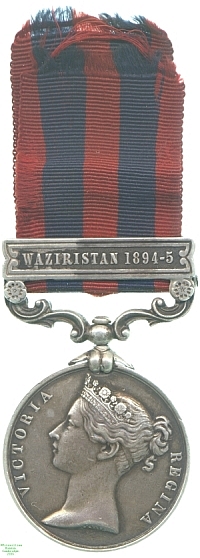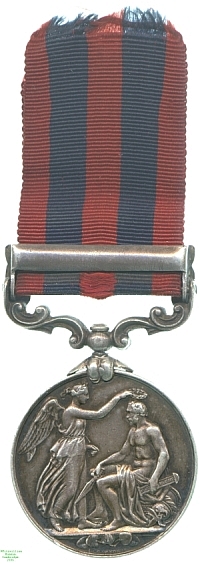
Obverse, a bust of Queen Victoria

Reverse, Victory crowning a seated Classical warrior with a laurel wreath

Obverse, a bust of Queen Victoria |

Reverse, Victory crowning a seated Classical warrior with a laurel wreath |
The Army of India Medal's issue in 1849 having marked the previous half-century's combats in the region, further conflicts in the 1850s led in 1854 to the design and issue of a General Service Medal for the theatre, for which bars would be issued as each new campaign merited.
British India met Afghanistan at the North-West Frontier. Since British influence over Afghanistan competed with the Burmese kingdom of Ava and Russia, the region beyond the frontier, composed of a large number of more-or-less independent tribal statelets, was of great importance to British interests and required continual suppression by `punitive expeditions'. For the lesser ones of these the North West Frontier bar was awarded in 1869, although some expeditions were thought to merit individual bars. Later campaigns received bars of their own, and the last bar awarded for the India General Service Medal was one of these, for a campaign into Waziristan in 1894 and 1895. A party whose task was to delineate the frontier with Afghanistan had been attacked and embroiled in a fierce battle at its camp; this merited the kind of punishment that these campaigns were designed to deliver.
South Waziristan is at the time of writing an independent Islamic fundamentalist state declared in defiance of Pakistan, of which it has otherwise been part since 1947. As Pakistan with suspected al-Qaeda terrorists in 2006, so Britain with fundamentalist insurgents in 1894. Among the troops sent to quell the earlier revolt was Private T. Savage of the 2nd Border Regiment, whose medal this is. Lester Watson purchased it at some point before 1928.